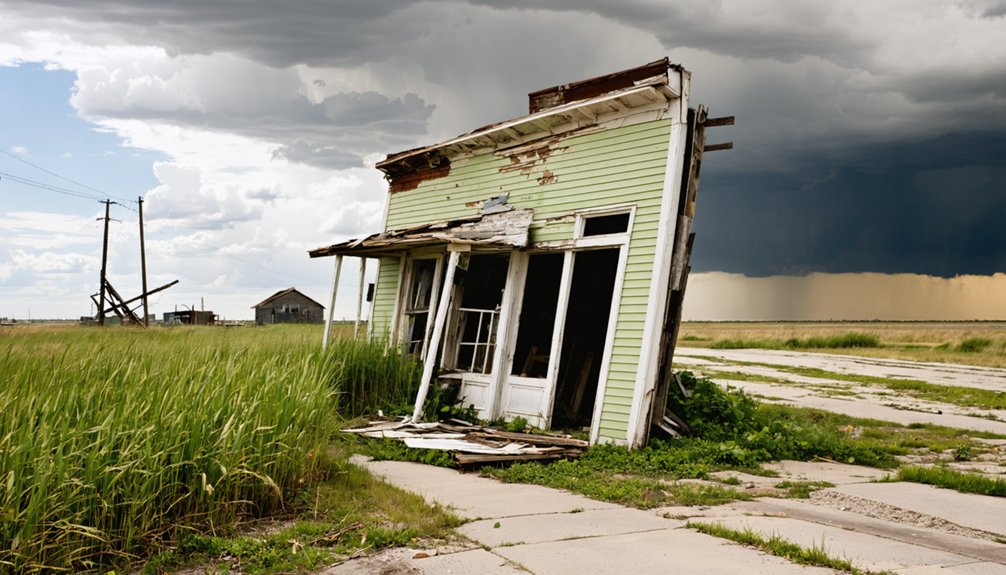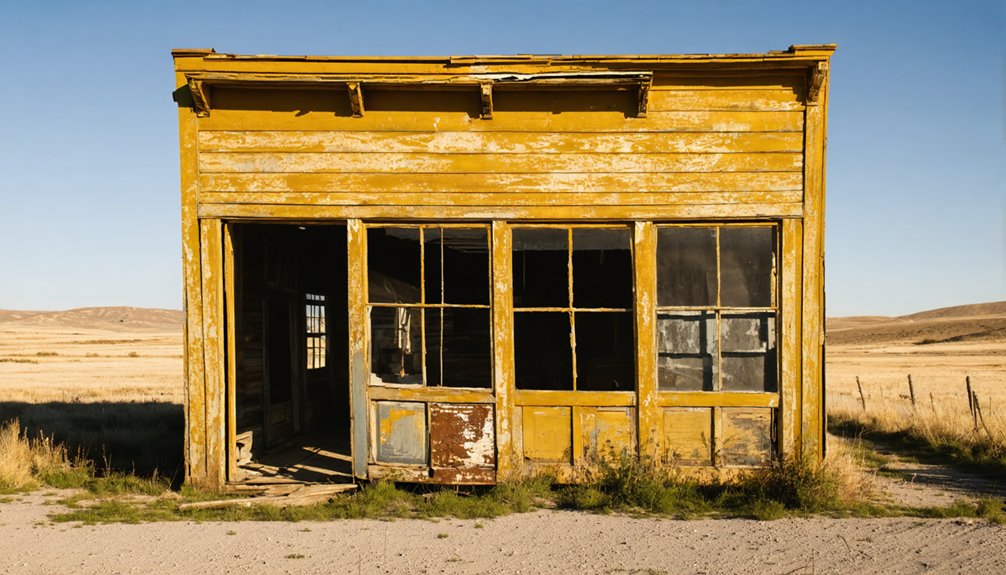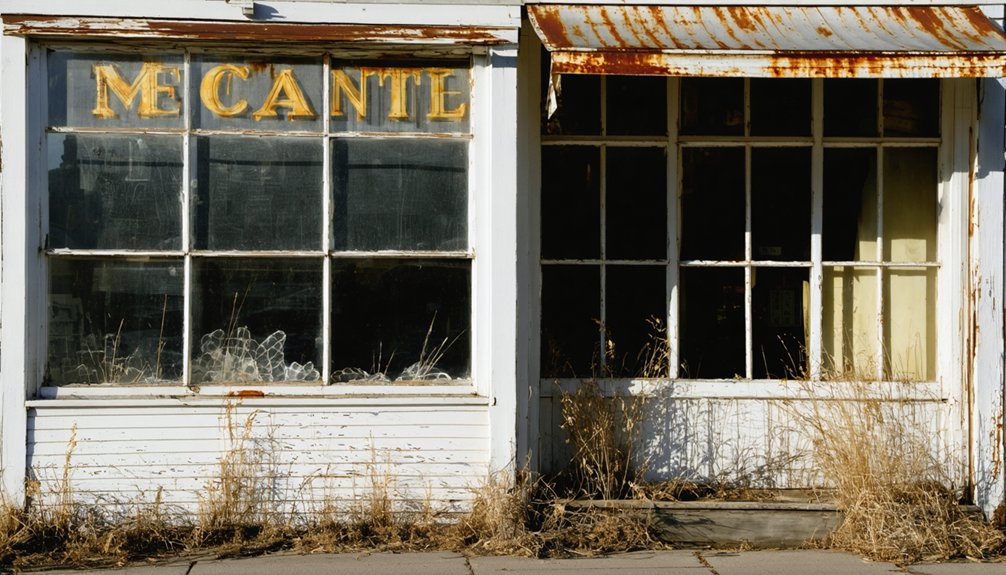You’ll find Golden Centre nestled in South Dakota’s Black Hills, where it boomed after Custer’s 1874 gold discovery expedition. The town flourished in the late 1870s as prospectors flooded the area, with the nearby Homestake Mine producing 10% of the world’s gold over 125 years. While the town declined as gold yields diminished, its remnants tell a compelling story of the Black Hills’ mining heritage, with weathered foundations and old mining equipment marking its historic presence.
Key Takeaways
- Golden Centre emerged during the 1874 Black Hills gold rush after the Custer Expedition confirmed gold deposits in the region.
- The town thrived alongside the Homestake Mine, which produced 10% of the world’s gold supply for 125 years.
- Economic decline began in the late 1870s as gold yields diminished, leading to widespread population exodus.
- The closure of the post office in 1971 marked the official end of Golden Centre as a viable community.
- Today, only scattered foundation remnants and weathered footings remain, with forest growth reclaiming most former building sites.
The Rise of a Black Hills Mining Camp
When the Custer Expedition confirmed gold’s presence in the Black Hills in 1874, it sparked a mining rush that would transform the region forever.
The 1874 discovery unleashed a stampede of fortune seekers, forever changing the untamed wilderness of the Black Hills.
You’d find thousands of prospectors flooding into the area by 1876, driven by gold fever and dreams of striking it rich. While many initially focused on placer gold in streambeds, the real wealth lay in the hard-rock deposits beneath. The discovery of the Homestake Mine in 1876 would go on to produce an astounding 10% of the world’s gold supply over the next 125 years.
As mining techniques evolved from simple panning to more sophisticated quartz crushing operations, settlements like Central City sprang up along the gulches. Gold production reached 1.5 million dollars in Deadwood Gulch during that first year.
You’ll recognize the pattern: tents and cabins gave way to saloons, gambling halls, and brothels. Despite the early lawlessness, these camps quickly developed into organized communities, complete with schools, churches, and newspapers by the late 1870s, marking the region’s shift from frontier outpost to established mining district.
Life During the Gold Rush Era
As prospectors and fortune-seekers poured into the Black Hills by the thousands in 1876, life in hastily built boomtowns like Deadwood took on a distinctly chaotic character.
You’d have found yourself in a raw-timber town where social dynamics shifted daily, with prospectors, merchants, and outlaws all rubbing shoulders in crowded saloons and gambling halls.
For a dollar a night, you could’ve secured a cot in one of the many boardinghouses that lined the muddy streets.
The transient populations brought both opportunity and danger – banks handled fortunes in gold daily, while disputes over claims often turned violent.
The bustling town of Deadwood reached 7,000 residents by mid-1876 during the peak of mining activity.
Women carved out roles as businessowners and service workers, though they remained outnumbered in this male-dominated frontier.
Despite the chaos, these instant communities fostered a uniquely American spirit of risk-taking and reinvention.
The rush of miners into this area directly violated the Fort Laramie Treaty that had guaranteed the sacred land to indigenous tribes.
Mining Operations and Economic Growth
The Homestake Mine‘s explosive growth transformed the Black Hills mining industry, establishing itself as the Western Hemisphere’s largest and deepest gold mine. By 1900, you’d find over 2,000 workers operating across 2,000 acres of mining claims, pushing the boundaries of mining technology with compressed air locomotives and advanced ventilation systems.
Over its operational history, one billion dollars in gold was extracted from the expansive mine. The region’s economic interdependence grew as mining operations evolved. You’ll see how the introduction of cyanide processing boosted gold recovery rates to 94%, while pneumatic drills and mechanized hoisting systems revolutionized underground work. Mining operations at Homestake spanned an incredible 126 years of production, making it one of the longest-running gold mines in history.
The town of Lead developed alongside Homestake, striking an essential balance between mining interests and community needs through surface rights agreements. The mine’s success funded regional ventures and infrastructure, turning the Black Hills into a thriving frontier of industrial innovation.
Notable Pioneers and Early Settlers
Throughout Dakota Territory’s transformation in the late 1800s, pioneers and settlers from diverse backgrounds shaped the region’s development.
You’ll find that pioneering families like Charles Miner, who first claimed land in Beadle County, and the German-born Baum brothers exemplified the determination of early settlers. Many used strategic settlement strategies, combining the Homestead Act, preemption options, and Timber Culture Act to build substantial holdings. Fur trading operations established over 100 trading posts throughout the region during the 1830s.
Civil War veterans turned politicians, including Arthur Calvin Mellette and Major John Pickler, played vital roles in establishing new communities. The rapid influx of settlers brought the territory’s population from just 1,000 white settlers in 1861 to 325,000 by 1887.
European immigrants, particularly Germans and Norwegians, created close-knit settlements near military forts and along railroad lines. These settlers often traveled hundreds of miles by wagon or on foot, driven by the promise of affordable land and the freedom to build new lives.
Daily Life in Golden Centre
Life in Golden Centre revolved around the steady rhythm of mining operations, with daily routines shaped by the harsh realities of frontier existence. You’d have found miners heading to work in simple wood-frame homes, while their families managed household duties and tended to subsistence activities to stretch limited incomes.
The town’s social hubs centered around the local saloons and general stores, where you could exchange news and supplies after long shifts in the mines. Like other towns in the area, Golden Centre was one of over six hundred ghost towns scattered throughout the Black Hills region. Miners often found deposits of silver and copper instead of the gold they initially sought.
Community gatherings often took place at the chapel, providing much-needed spiritual comfort and social connection in the isolated settlement. When you weren’t working, you’d join your neighbors at local boarding houses or informal meeting spots, where the shared challenges of mining life forged strong bonds among residents.
The Town’s Rapid Decline
As gold yields diminished in the late 1870s, Golden Centre’s once-bustling streets quickly emptied of miners and merchants alike.
You’d have witnessed the rapid exodus as major mines shuttered their operations and processing mills fell silent. Multiple decline factors converged – the closure of shaft houses, the abandonment of ore bins, and the dismantling of crucial tramways.
The town’s economic isolation intensified when anticipated railroad connections never materialized.
You couldn’t sustain a business when stagecoach routes dwindled and supply chains crumbled. The post office’s closure in 1971 marked the final blow to community viability.
Like many Black Hills mining settlements, Golden Centre couldn’t recover as essential services disappeared. Schools, firehouses, and municipal buildings deteriorated while remaining residents struggled with diminishing access to healthcare and education.
What Remains Today

You’ll find remnants of Golden Centre’s mining legacy in its surviving shaft houses, mine foundations, and scattered industrial equipment from the town’s heyday.
The site features deteriorating Victorian Gothic-style buildings and processing facilities, with rusted cyanide vats still visible across the valley floor.
While most structures stand roofless or in ruins, you can access the ghost town through marked historical points that local preservation groups maintain for educational tours and heritage walks.
Physical Structures and Ruins
Today’s Golden Centre ghost town reveals little of its former frontier aspirations, with most structures having succumbed to decades of Black Hills weather and neglect.
If you’re planning ruins exploration, you’ll find mostly scattered foundation remnants and weathered footings where buildings once stood proudly during the mining boom era.
The site’s architectural significance has largely faded as natural processes reclaim the land.
You’ll discover that much of the area has returned to its natural state, with forest growth overtaking former building sites.
While walking the grounds, you might spot traces of late 19th-century construction techniques in the few remaining structural elements.
The ghost town now serves primarily as a silent indication of the region’s boom-and-bust mining heritage, attracting history enthusiasts and curious adventurers.
Mining Equipment Remnants
Mining equipment remnants at Golden Centre offer sparse evidence of the site’s industrial past, with most machinery having been removed through systematic salvage operations or lost to decay.
You’ll find few traces of the once-bustling ore processing operations, as the site’s crushers, stamp mills, and amalgamation tables have largely disappeared.
If you explore the area, you might spot scattered remnants of rail tracks where ore cars once transported material, or concrete foundations that anchored heavy mining machinery.
While the massive hoisting systems and headframes that once dominated the landscape are gone, occasional fragments of drilling equipment or rusted pipe sections from water management systems can still be found.
Most surviving artifacts from Golden Centre’s mining era are now preserved in regional museum collections.
Historical Access Points
While much of Golden Centre has succumbed to time, several key access points from its heyday remain visible across the landscape.
You’ll find historical transportation routes that once served as essential lifelines for this mining community, including remnants of the original railroad grade and weathered wagon trails connecting to Rochford.
- Original dirt and gravel roads, though overgrown, still trace paths between former mining camps.
- Railroad bed remnants showcase the town’s significant supply and transportation infrastructure.
- Historic wagon trails reveal the routes used for ore and supply movement.
- Forest roads from logging operations now provide limited modern access.
Today, these access pathways are restricted by gates and warning signs to protect both the property and visitor safety, though they continue to tell the story of Golden Centre’s bustling past.
Historical Legacy and Preservation Efforts

Despite its fading physical presence, Golden Centre stands as a tribute to the Black Hills’ rich mining heritage of the late 19th century.
You’ll find remarkable archaeological significance in its deteriorating shaft houses, massive cyanide vats, and scattered ore bins that tell the story of a once-bustling mining community. These remnants offer a window into the technology and life of the region’s gold rush era.
The site’s preservation challenges mirror those of many Black Hills ghost towns. While historical societies work to document Golden Centre’s past through archives and journals, the remote location and complex ownership issues limit active conservation efforts.
Though few formal markers exist today, the town’s fragile foundations and mining structures continue to provide valuable insights into South Dakota’s pioneering spirit and mineral extraction history.
Frequently Asked Questions
What Was the Highest Recorded Temperature Ever Documented in Golden Centre?
You won’t find direct temperature records for Golden Centre, but based on regional climate history and nearby Aberdeen’s documented extremes, the highest likely temperature reached was 115°F during 1930s heatwaves.
Were There Any Reported Paranormal Activities or Ghost Sightings in Golden Centre?
After a million searches, you won’t find documented ghost stories or haunted locations tied to this place. Historical records and local accounts don’t mention any paranormal activity happening there.
Did Golden Centre Have Its Own Newspaper During Its Brief Existence?
You won’t find evidence of any Golden Centre newspaper or local publications. The town likely relied on regional papers like the Black Hills Pioneer in Deadwood for its news coverage.
What Indigenous Tribes Lived in the Area Before Golden Centre’s Establishment?
You’ll find that Lakota bands primarily inhabited the region, shaping the area’s tribal influence through their distinct culture. The Brulé, Oglala, Miniconjou, and other Sioux groups called this territory home.
Were Any Movies or Television Shows Ever Filmed at Golden Centre?
While South Dakota’s film history includes famous spots like Mount Rushmore and the Badlands, you won’t find any television productions or movies shot at this remote ghost town’s crumbling remains.
References
- https://www.legendsofamerica.com/galena-south-dakota/
- https://www.sdpb.org/rural-life-and-history/2023-08-21/some-black-hills-ghost-towns-and-their-origins
- https://news.icpc.global/2017/04/22/gold-dreams-became-a-ghost-town-in-south-dakota/
- https://www.youtube.com/watch?v=Glucs_Rq8Xs
- https://www.powderhouselodge.com/black-hills-attractions/fun-attractions/ghost-towns-of-western-south-dakota/
- https://www.blackhillsbadlands.com/blog/post/old-west-legends-mines-ghost-towns-route-reimagined/
- https://en.wikipedia.org/wiki/List_of_ghost_towns_in_South_Dakota
- https://www.sdhspress.com/journal/south-dakota-history-2-2/some-black-hills-ghost-towns-and-their-origins/vol-02-no-2-some-black-hills-ghost-towns-and-their-origins.pdf
- https://ruralresurrection.com/ghost-towns-mystic-south-dakota/
- https://en.wikipedia.org/wiki/Black_Hills_gold_rush



